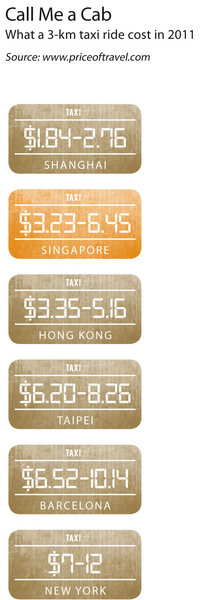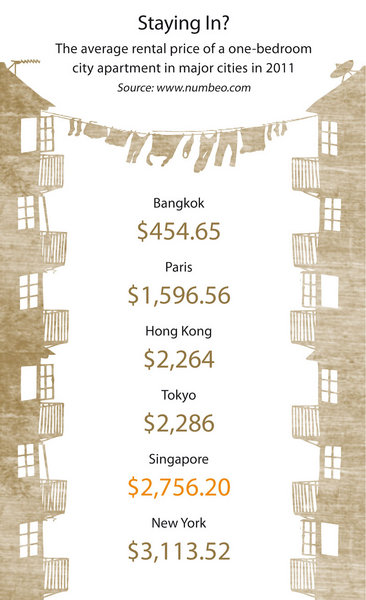Is Singapore (Still) Worth it?
Terry Ong crunches the numbers and talks to lifestyle industry experts about rising prices.
Like it or not, Singapore is now the most expensive city in Southeast Asia to live in, coming in at number 10 in a recent survey conducted by UBS (see below). It was only just a few years ago that we could boast about being more affordable and certainly more “attractive” than our regional rivals: rents were reasonable, eating out didn’t mean breaking the bank and public transport was an altogether more pleasant experience.
The World’s 20 Most Expensive Cities
Source: UBS
So what happened? Is Singapore still worth our time or is it now just too darn expensive? Ask around and the jury is still out. “It’s a city where only the rich who have lots of money to blow can afford to have fun,” says freelance columnist Tay Yek Keak. “With overall costs continuing to escalate and paychecks at a standstill, it’s increasingly harder for the average folk to get by in this town.” Others, like St. James Power Station’s CEO Dennis Foo, assert that Singapore is still the premier place in the region to “live, work and play.” And that comes down to more than just what money can buy. “New York, London, Paris, Tokyo: they are all great cities,” says Foo. “But to me, Singapore is better as it is more modern, better governed, very secure, and is well connected to the world. We are also more vibrant now than ever.”
We certainly do well when it comes to Quality of Life rankings (see below), beating out all the Asian competition and bumping up against bigger cities blessed with much longer histories. But that undoubtedly comes at a cost, and our escalating numbers are not very encouraging, especially with the recent surge in property prices (both private property and HDB prices have gone up approximately 75-100% over the past two years in both central and suburban areas, says our property spokesperson), which has created a domino effect on wining and dining, shopping and entertainment.
Quality of Life* index ranking of cities across the world in 2011
Source: www.mercer.com
*The Quality of Life Index is determined by factors such as socio-political environment, economic environment, natural environment, housing, health-care, cultural environment, recreation, schooling, public services, and transportation.
The cultural scene may never have been better, but concert promoters like Michael Roche of Lushington Promotions says it’s simply impossible to keep costs down while bringing big acts in. A one-night rental of the Singapore Indoor Stadium averages $100,000, and apart from outdoor venues like Fort Canning, we simply “do not have enough venues to play with,” he says. “We’d love to push ticket prices down ... but unless we are able to find more accessibly priced venues and artistes are willing to put in grungier venues, it is not likely to happen soon.”
On the flipside: although prices have escalated, the number and quality of acts performing here have also risen over the years—thanks to quality events like the annual Laneway Festival, F1 and Mosaic Music Festival which featured many international acts who bypassed neighboring cities like Kuala Lumpur, Jakarta, Bangkok and even Hong Kong to perform here. “Singapore has always managed to secure a high standard of international artistes and the number touring this region has certainly increased hugely,” says Midas Promotions’ Steven Woodward. “The concert scene has continued to evolve, in some part due to the support of the government here as they continue to encourage multiple forms of entertainment.”
But wait a minute—there’s no shortage of free or great-value events. A few cases in point: Free art exhibitions at private galleries and museums on selected days, free outdoor concert performances at the Esplanade (“We want to reach out to as many people as we can and remain accessible to people from all walks of life,,” says Clarence Yap, assistant director of programming) and affordable entries into clubs with major DJs headlining.
And at least clubbing and drink prices have remained relatively static (if not the cheapest) over the years: “Compared to other clubs in Asia, the US or even Europe, Singapore’s club entrance prices are definitely value-for-money, with many clubs in Singapore including one or two drinks with the price of entry,” says Zouk’s director of marketing Timothy Chia. “We have set the local industry standard with this practice which can also be seen in a few other Asian cities, although it is not a global industry norm by any means. We want to give clubbers here more bang for their buck.” Over at St. James Power Station, Dennis Foo points out that “Our alcohol prices have stayed the same for a long, long time. The price of beer at bars and clubs was around $8 back in the ‘90s, and they still cost the same now ... we are certainly cheaper than most parts of the world,” he says.
Raymond Lim, who runs fine dining establishment Les Amis, admits that when it comes to eating out, prices in Singapore are “on the high side compared to neighbouring cities like Hong Kong. In fact, we are on the high side even by European standards. A top restaurant like L’Atelier de Joël Robuchon in Paris charges about $400 for a degustation menu, while over at Les Amis a degustation menu costs $360, so we’re pretty close. Eleven years ago, the same menu in our establishment cost $135, but this is due to the overall rising cost of running a business, which includes inflationary factors like salaries, costs imported ingredients and rental. Everything has been pushed up a few notches in Singapore, especially with the arrival of Michelin-star restaurants with new benchmarks for prices being set, albeit artificially so in some cases.”
Yet hawker food remains cheap, with the government promoting new initiatives to ensure healthier options minus the high prices. Industry insiders like Yuan Oeij, executive chairman of The Privé Group, says that “Singapore is extremely good at affordable cuisine. Our local food is delicious and is among the cheapest in the developed world. We are experts at turning poor to moderate quality ingredients into great tasting food. Just think about all the local favorites like char kway teow, prawn mee and hor fun that we have.”
More and more mid-priced bistros and cafes are opening, too, offering a greater choice of price-points than ever before. And it’s choice that all of this really boils down to—a truly great city makes it easy for anyone to go out and eat; not stay at home bemoaning the lack of options.

There is then no question that this is an expensive town. To name and shame a few other offenders: Rent is among the highest in the world, wine is far pricier than it ought to be, shopping can be a dangerous habit. But it pays to step back and think about all the good along the bad. Plain and simple: the city works. That’s more than can be said for plenty of places often cited as “amazingly cheap.” Ironically, one of the very best value-for-money things here is the incredible range of such destinations easily accessible via reliable budget airlines. You want clothes as cheap as a Bangkok’s Chatuchak or street food as cheap as Shanghai? Fly there for the weekend—you’ll likely come back not just with a bagful of new outfits and a full stomach, but a renewed appreciation for our green, clean, and increasingly vibrant city.
You envy the mind-boggling number of edgy, alternative arts events in somewhere else like London? Try living there and listening to people complain about tube breakdowns, a stagnant job market and high taxes, and see if you don’t prefer the sunny optimism here. That’s not to say we should stomach any amount of inflation or not hold people, venues and institutions to account for offering poor value-for-money; just that the bigger picture is what matters.

St. James Power Station’s Foo concurs. “We are a city state after all, good and bad. Depending on what you’re looking for, you can find different entry points to a range of experiences both in and out of the city,” he says. “We are one of the few very cities in the world where the income gap between the general working and middle classes are not that high, and certainly we have one of the best infrastructures in town and one of the nicest cities in the world to live in. Even our taxi drivers can find their little holidays here and there.”
Advertisement